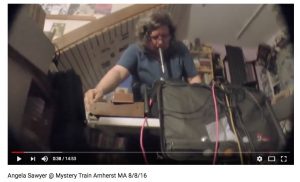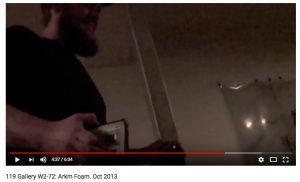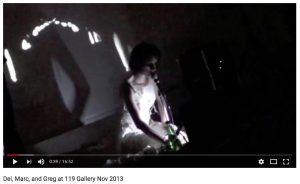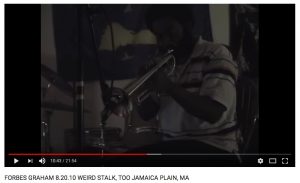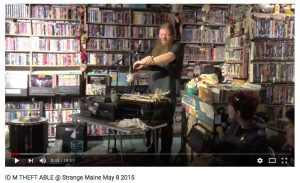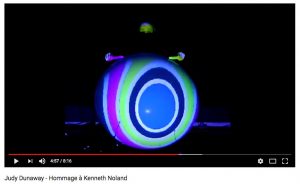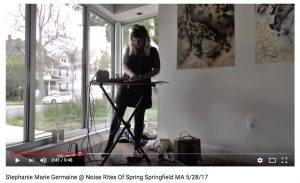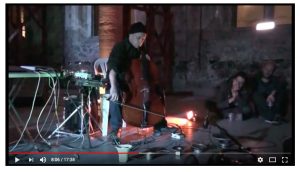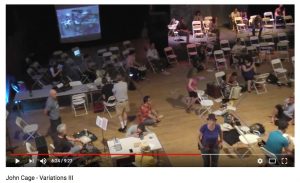We have been playing John Cage’s “Variations III” since well before Lou Cohen’s death in 2013. Lou studied with Cage and would organize yearly performances of this work by musicians from the Boston experimental music community. At the 2017 “New Music Gathering” in Bowling Green Ohio, Tim Feeney and I arranged a performance of “Variations III” to express our connection to Lou through Cage’s piece. Before we played, Tim said a few words and quoted our friend, and saxophonist, Dave Gross:
“The best thing about this music is that your heroes become your friends.”
Lou was our hero and our close friend. He was also a mathematician, computer programmer and composer of highly original computer music. Near the end of his life, he released a 3 hour long album of this music which was “composed by means of algorithmic and stochastic processes”:
https://loucohen.bandcamp.com/
* * *
Some of you may know Tim or his music, or both. I am particularly fond of Tim’s piece “Things I Said I’d Never Be” for its stillness, uncompromising length, and interaction between a live performer playing “continuous and detailed sounds” and field recordings chosen by the performer. Tim is my hero for writing this music.
https://soundcloud.com/aaronmbutler/feeney-things-i-said-id-never-be
I have other heroes too, some listed below. Some I know well, and others I don’t.
* * *
This past summer I received an email from Jeff Stolet asking me to review applicants to the 2018 SEAMUS conference in Eugene, Oregon. I quickly accepted wondering what my SEAMUS friends are up to, having not been to a conference in a couple years. After listening to 40 or so hopefuls, I had some questions: What is everyone listening to? What forms, ways, and sounds are influencing the SEAMUS zeitgeist? Who are the applicants?
* * *
I noticed a certain uniformity in the music among some of the SEAMUS applicants. This can be valuable to an artistic community, creating a sense of identity and a common vocabulary of means. Of course difference is also valuable, as it can challenge and change artistic outlook by tracing new lines, forming webs, among and between works of a similar vein, expanding out to the different. Even if this different is not of interest, studying these spans of difference, in all their degrees, may help evaluate the familiar-ness that a community of musicians naturally forms.
Below is a playlist of sorts, from which I can draw interesting lines of difference (différance?) from the SEAMUS works I reviewed, and for that matter, among those on the playlist. Most of the musicians perform or exhibit some kind of live electronic instrument, and live in New England. This list is not intended as a “best of,” but is more a curated sample of musicians I respect, whose music I enjoy, and who I have heard play live, some many, many times.
My hope is you may like some of it too.
Andrea Pensado:
live vocal processing and synthesis through Max/MSP

https://www.youtube.com/watch?v=OshmpGUOUQ0
Angela Sawyer:
live electronic sound, duck call, and voice
https://www.youtube.com/watch?v=UiPrLuaUY6g
Arkm Foam:
live tape manipulation and chair
https://www.youtube.com/watch?time_continue=7&v=GAilgK2hgsA
Asha Tamirisa:
laptop
https://soundcloud.com/ashatamirisa/grm
Dei Xhrist:
vocal reproduction of musique concrete, direct and through a Line 6 DL4 delay modeler pedal
https://www.youtube.com/watch?time_continue=33&v=xSyX7pie1S8
Ellen Band, “Swinging Sings”
for tape and live violins
http://www.ellenband.com/audioplayer/playlists/swinging_sings.html
Forbes Graham:
trumpet, laptop
https://www.youtube.com/watch?v=fFDoSSCO2SQ
Id M Theft able:
voice/body, contact mics, found objects, tape, feedback
https://www.youtube.com/watch?v=Y9UpQvcQMwk
Jane Wang, “Memory 1a”
a meditation on the dream state using recordings of rats brains
https://soundcloud.com/soundjw
Jenifer Gelineau:
amplified glass, violin, effects pedals, electronic sound
https://www.youtube.com/watch?v=8KQUYRO3m7A
Judy Dunaway:
“Hommage à Kenneth Noland” for amplified giant balloon, vibrators, synthesized tones and projected video animations
http://www.judydunaway.com/amplified-giant-balloon.html
Marek Poliks:
“Interdictor” for aluminum and plexiglass object, 640 computer fans, 25 arduino megas, 6 transducers
https://soundcloud.com/marek-poliks/interdictor-exhibition-version-2017
sound collage, field recordings, restless electronics, tapes, objects, voice and video
https://www.youtube.com/watch?v=G7iY5qVPaOY
Vic Rawlings:
amplifier/ prepared cello, speaker elements/ exposed circuitry
https://www.youtube.com/watch?v=nd9vPFw4kV0
* * *
I am very glad Steve Ricks invited me to write a regular column in the SEAMUS newsletter. I hope to engage this community by featuring beautiful moments of music, and beautiful uses of technology, by musicians whose voice and aesthetic perspective is perhaps not central to the SEAMUS zeitgeist, to the extent that is a thing I can know. My purpose is not so much about analysis, critique or rational findings, but more about linking, tracing, discovery, and of course listening.
* * *
Dave’s quote from above is worth repeating:
“The best thing about this music is that your heroes become your friends.”
Dave posted this on a Facebook thread about Jed Speare, who had recently died. Jed’s piece “Mettle of Metal” uses the sound of cable cars to propose a place through a lovely ringing asymmetry. While I met Jed several times, I regret not getting to know him better.
https://soundcloud.com/ear-room/jed-speare-mettle-of-metal
You might also like Dave’s work. While not electronic, he improvises on the sax like a sound making machine, as Helmut Lachemann put it “Musique Concrète Instrumentale.” In this set, Dave also live manipulates a turntable at the beginning:
https://www.youtube.com/watch?v=9KDAsbYR35o
Dave and Jed are my heroes too for making this music.
* * *
I don’t know if meaning in music is comprehensible through words, or in any way absolute –but perhaps some meaning is occasional, some is from a maze of difference, and some is metaphysically bound to knowing the people who make it. About 10 months after Lou Cohen passed, many of the musicians mentioned in this essay participated in a 100 person performance of Cage’s “Variations III.” This was a deep one:
https://www.youtube.com/watch?v=vKWP0yHIUPQ
* * *
See you soon,
Lou


